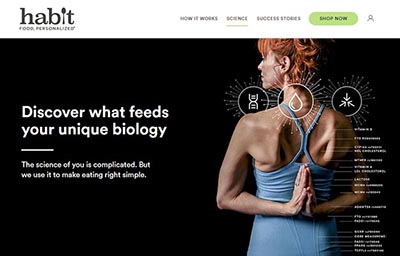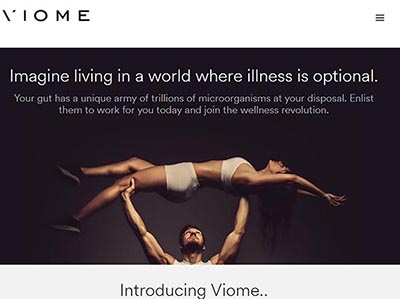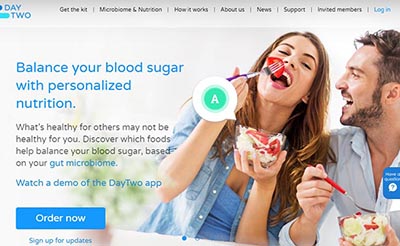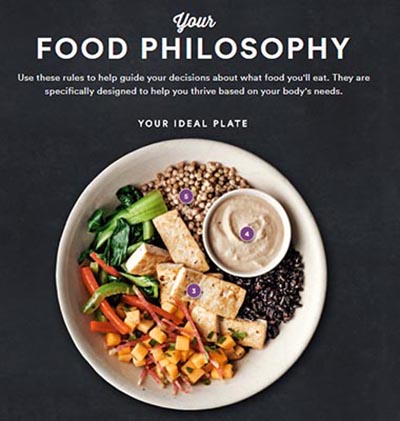Personalized nutrition: Do you need a just-for-me diet?

"You’re not the same as everybody else, so why follow everybody else’s diet?” asks DNAFit’s website. “Let’s end the guesswork and dieting. Find out what foods are uniquely right for you,” offers Habit.com. Do you need to “make nutrition personal”?
“We’re giving recommendations to populations, but people want to know what works for them,” said Ahmed El-Sohemy, professor of nutritional sciences at the University of Toronto and founder of the personalized nutrition company Nutrigenomix.
El-Sohemy was speaking at a National Academy of Medicine workshop on “Nutrigenomics and the Future of Nutrition” in December 2017. (Nutrigenomics is the study of how nutrients interact with genes.)
Who wouldn’t want diet advice tailored to their needs?
“We hope, in the long term, that personalized nutrition saves you from a heart attack, an osteoporotic fracture, cancer, chronic degenerative disease, and so on,” says Christopher Gardner, professor of medicine at Stanford University School of Medicine.
With new technology, researchers are beginning to tie together enormous amounts of data about a single person: genetics, the microbiome, blood biomarkers, lifestyle habits, and more. That data may someday lead to individual advice.
But someday isn’t now.
“We’re in personalized nutrition’s infancy in part because it’s so complex,” Gardner explains. “We’re starting to chip away at it, but we’re not there yet.”

Your Genes
“You are born with a unique genetic blueprint,” says Habit.com, the biggest name in direct-to-consumer personalized nutrition services. (Habit was started with a $32 million investment from Campbell’s—the soup people.)
“Our partnered CLIA-certified lab analyzes those nutrition-related genetic markers. These markers lay the foundation for your results.”
But it’s not clear how much genetic markers can help you. For example:
FTO. People with a variant of the FTO gene are more likely to be overweight or obese.1 But that doesn’t tell you much.
“If the risk variant for FTO helps to make you fatter, does that make it harder to lose weight?” asks John Mathers, director of the Human Nutrition Research Centre at Newcastle University in England.
To find out, he looked at eight weight-loss studies that enrolled roughly 9,500 overweight or obese volunteers.2
“People lost weight just as effectively whether they had or didn’t have the risk variant for that gene,” Mathers explains.
“I think that’s very encouraging for people, because it means that their genes are not always their destiny. They can lose weight even if they carry the risk variant.”
His results should come as no surprise. Researchers have found 97 gene variants linked to weight, but together, they only explain roughly 3 percent of the differences in weight between people.3
PPARG, ADRB2, FABP2. Gardner’s DIETFITS study used variants of three genes— PPARG, ADRB2, and FABP2—to classify people as more sensitive to fat (low-fat genotype) or to carbs (low-carb genotype).4
Then the researchers randomly assigned 609 overweight adults to eat either a healthy low-carb or a healthy low-fat diet for a year. The low-carb group ate more healthy fats like avocado, salmon, and nuts. The low-fat group ate more beans, fruit, and whole grains.
But the dieters’ gene patterns didn’t help predict how much weight they would lose (about 12 pounds, no matter which diet they were on). “Other genes or gene patterns might matter, but the patterns we looked at did not,” says Gardner.
Other genetic tests may tell you what you already know. Of the 25 genetic variants that Habit tests, 18 reveal if you have a higher risk of:
- high blood sugar
- low HDL (“good”) cholesterol
- high triglycerides
- high blood pressure
- excess weight
- low vitamin D levels
- lactose intolerance
- metabolizing caffeine slowly
But chances are, you already know if you have gas, diarrhea, or bloating after drinking milk or whether a cup of coffee after lunch will keep you up all night.
And an ordinary checkup can tell you if your blood pressure, blood sugar, triglycerides, or weight is high or if your HDL or vitamin D is low.
What’s more, “for type 2 diabetes, body weight, and cardiovascular disease, non-genetic risk factors are much more important than your genetic risk,” says Cecile Janssens, research professor of epidemiology in the Rollins School of Public Health at Emory University. She’s talking about your blood pressure, blood sugar, HDL, etc.
And because genes aren’t the whole ball of wax, companies like Habit don’t stop there.
“In the early days, almost everyone just talked about genetics, but now researchers are studying a much broader range of characteristics,” notes Mathers.
“I think that’s a sensible move, because genetics are only one part of the picture.”
The Microbiome
“Your gut has a unique army of trillions of microorganisms at your disposal,” says Viome. “Enlist them to work for you today and join the wellness revolution.”
For a mere $399 (and a stool sample), Viome offers “a personalized, easy-to-follow plan with precise diet, nutrition and supplement recommendations” based largely on the microbes in your gut.
But the evidence to back up that advice is “pretty thin,” says Mathers.
“Much of the microbiome work is interesting,” he explains, but so far, it has only revealed links, not what explains them.

For example, Danish researchers measured two types of bacteria—Prevotella and Bacteroides—collected from 62 adults in a study pitting the New Nordic Diet (which is rich in whole grains, vegetables, and fruit) against an average Danish diet (which is high in refined grains, added sugars, meat, dairy, and processed foods).5
After six months, participants who had relatively more Bacteroides at the start of the study had lost a similar amount of body fat on either diet. But those with relatively more Prevotella lost seven more pounds of fat on the New Nordic Diet than on the average Danish diet.
Interesting. But that doesn’t tell you much. Could something else about people with relatively more Prevotella explain why they lost more fat on the New Nordic Diet?
What’s more, most people have no idea which bacteria they have more of. And even if they did, no one knows how to change the microbes in their gut.
“There’s not yet enough evidence demonstrating that if you eat X or Y, you produce these particular changes in your microbiome and they translate into some health outcome,” says Mathers.
Blood Sugar
In 2015, Israeli researchers released surprising news from a study measuring how the blood sugar of 800 people responded after they ate a total of more than 47,000 meals.6
“They monitored enough people and enough eating episodes that they could say, ‘Two people eating the same amount of carrots or cookies or broccoli would have very different blood sugar responses,’" says Stanford’s Christopher Gardner.
The researchers combined that information with other data—on the participants’ diets, weight, exercise, gut microbiomes, and more—to predict how different people’s blood sugar would react to eating different foods. Their goal: to devise diets that prevent spikes in post-meal blood sugar.
The result: DayTwo, which, for $349, will design a personalized diet for you.
While the research behind DayTwo is impressive, says Gardner, “I’m skeptical, to say the least. You can’t pin the risk for diabetes or cancer or heart disease solely on blood sugar.”

That also goes for weight loss.
Gardner’s DIETFITS study tested whether people who appeared to have insulin resistance would lose more weight if they cut back on carbs more than on fat.4
(Insulin resistance—which means that your insulin isn’t good at moving blood sugar into your cells—often goes hand-in-hand with high blood sugar and often leads to type 2 diabetes.)
“It makes a lot of intuitive sense that people who are on their way to diabetes would have a hard time handling carbs,” notes Gardner.
Half of the people in the DIETFITS study ate a healthy low-fat diet, and half ate a healthy low-carb diet. “And we asked everybody to get rid of refined grains and added sugars and to eat as many vegetables as possible,” explains Gardner.
But after a year, the participants with the highest insulin secretion lost no more weight on a low-carb diet than on a low-fat diet. (A person with greater insulin secretion may have insulin resistance, which is difficult to measure.)
“I totally bought into the idea that those folks would do better on a low-carb diet,” Gardner acknowledges.
His bottom line on DayTwo: “I’m really happy when people add new tools to the research toolbox. But I’m really frustrated when it gets turned into ‘We’re done! Thank goodness we figured it out. Now we know what you should eat.’”
Secret Formulas
“Partnering with experts in the fields of systems biology and nutrition, we make sure that the connection between each test result, metric, and recommendation we make is backed by significant scientific evidence,” says Habit.
But that evidence is a secret.
“There is a lack of transparency,” says Emory’s Cecile Janssens. “We have no clue what they are doing.”
And Habit’s formula for creating personalized diets may sound more advanced than it is. “Using a proprietary formula sounds so chic,” says Janssens.
“‘Trust us, it’s complex. Believe us,’ the company seems to be saying. I don’t think there’s anything complex behind it.”
Newcastle University’s John Mathers also wants to see the data.
“You could argue that if people want to waste money on some ‘harmless’ product, then so be it,” he says. “But if it’s going to be a serious attempt to make a difference to public health, then I’d like to see those programs based on solid evidence.”
The first generation of personalized diet services could also have other downsides.
“My biggest fear isn’t that we will hurt people physically,” says Gardner.
“It’s that we will get people more and more frustrated with scientific knowledge. These companies have overstepped the science, making claims that aren’t true. People will try it, be unsuccessful, and we’ll lose their trust even more.”
Good Advice Ignored?
“The same dietary advice cannot be good for everyone, because we are all different,” Eran Elinav told the New York Times in 2016. Elinav is co-author of the study that led to DayTwo and professor of immunology at the Weizmann Institute of Science in Israel.
“This is why we have failed so miserably at controlling the obesity epidemic.”
Mathers disagrees.
“There is nothing wrong with the dietary guidelines,” he argues. “The problem is that people don’t follow them.”
That’s the one upside of personalized diets: In Mathers’s Food4Me study, people were more likely to follow diet advice if it was tailored to their needs.7
“If we give people sound advice that is relevant to them, that helps to motivate diet change,” says Mathers.
But what most of us need doesn’t require a personal diet plan.
“Americans get a quarter or more of their calories just from added sugars and refined grains, and they get an embarrassingly low number of calories from vegetables,” says Gardner.
Shifting to a veggie-rich diet that’s low in white flour and added sugars would have a huge impact, no personalization required.
“It’s not about being a meat eater or a whole-wheat eater,” says Gardner.
“If you could get everybody to do the added sugar, refined grain, vegetable thing first, then you could tweak around the edges. But I’m not sure there’d be much left to tweak.”
To help people make those changes, the food environment—with pizza, burritos, burgers, fries, sodas, shakes, chips, doughnuts, waffle cones, and more at our fingertips 24/7—has to change.
“We just have way too much packaged, convenient, hyper-palatable, ultra-processed food,” says Gardner.
And without those changes, he adds, even the best personalized diet advice won’t matter.
“Unless we change the food environment and social norms, it’s going to be nearly impossible for people to cut back on refined grains and sugars, and to also make those smaller tweaks.”
References
1Science 316: 889, 2007.
2BMJ 354: i4707, 2016.
3Nature 518: 197, 2015.
4JAMA 319: 667, 2018.
5Int.J. Obesity 2017. doi:10.1038/ijo.2017.220.
6Cell 163: 1079, 2015.
7Int. J. Epidemiol. 46: 578, 2017.
Should you get in the Habit?
“I’ve noticed that my clothes are looser on my body,” says Michelle H., one of the “success stories” on Habit.com. “I feel better. I noticed that I have more energy.”
Is it worth $299 to “take the Habit Nutrition Test,” receive your test results, and get your “nutrition plan”?
I decided to find out. First, I answered online questions about my height, weight, waist, blood pressure, and activity level. Then, once the Nutrition Test Kit arrived, I fasted for 12 hours.

I swabbed the inside of my cheeks to collect DNA for the genetic testing. I pricked my finger and dripped blood onto a collection card, so Habit could analyze the blood for my fasting blood sugar, cholesterol, and triglyceride levels.
Next came the “unique metabolic challenge” to find out how my body handles fats, carbs, and protein. I gulped down Habit’s sickeningly sweet Challenge Shake, which clocks in at 950 calories, 18 teaspoons of added sugar, and more than a day’s saturated fat. Urp.
After 30 minutes, I stabbed another finger for blood, and 90 minutes later, I went for a third finger. Done!
A few weeks after I sent off my samples, an email popped into my inbox. Exciting new information about me was just a few clicks away! Except it wasn’t.
Take the genetic results. It turns out I have two high-risk variants of the FTO gene, which are more common in people who are overweight or obese. (I’m neither.) Be “mindful of your genes,” instructed Habit, without telling me how.
I don’t have the gene variants that make people lactose intolerant or sensitive to caffeine, reported Habit. I didn’t need a genetic test to tell me that.
I have four gene variants linked to high blood sugar. However, according to Habit, my response to the Challenge Shake was “impressive.” Two hours after the last gulp, my blood sugar was almost down to my fasting level.
“You handled the fat in the Habit Challenge Shake with ease,” said my results, apparently because the shake didn’t make my triglycerides soar. “However, your bad (LDL) cholesterol level is high.” (At 107, my LDL was slightly above the 100 target.)
My fasting blood sugar, triglycerides, and good (HDL) cholesterol were normal—no surprise, since my doctor had measured them recently.
Then came my “Nutrition Plan.”
“You are a Range Seeker,” said Habit. Among the rules that should guide what I eat:
■ “You thrive on a wide variety of whole foods that are naturally nutrient-rich.” (Who doesn’t?)
■ “Due to how your body processes carbs, hidden sugars can have the wrong kind of impact.” (Don’t they always? And weren’t my blood sugar results “impressive”?)
■ “With 30% of your calories from fat, enjoy nuts, plant-based oils or other healthy options like avocados.” (True for everybody, no?)
■ “You have the genotype associated with increased inflammation... Consuming more foods rich in vitamin C... [and] vitamin E...may be beneficial to you.” (“May” is right. It’s not clear if C and E help.)
I don’t know what Habit recommends for “Protein Seekers,” “Plant Seekers,” “Fat Seekers,” or its three other seekers. But the advice for Range Seekers is pretty generic.

I also got a list of “Hero foods”—swiss chard, asparagus, quinoa, apples, eggs, tofu, almonds, olive oil, and kidney beans. “Why kidney beans instead of, say, chickpeas?” I asked a Habit dietitian.
“If you want to have chickpeas instead of kidney beans, that totally works,” she replied. So much for personalization.
And why did Habit give me targets—the usual Recommended Dietary Allowances—for 12 vitamins and minerals, but no advice for calcium, iron, or sodium? The dietitian couldn’t say. (Habit declined my request to speak with a staff scientist.)
On the plus side, Habit’s diet plan was loaded with fruits, vegetables, and other healthy foods. The advice may not be “just for you,” but at least it seems to be good advice.
By Caitlin Dow
Photos: royyimzy/stock.adobe.com (DNA), Alta Oosthuizen/stock.adobe.com (woman), CSPI (Caitlin Dow).

